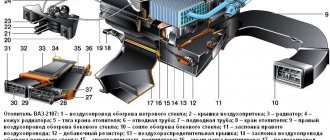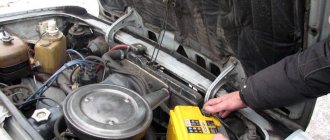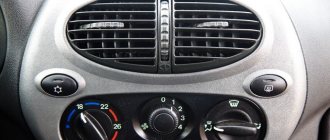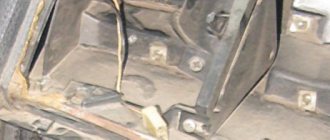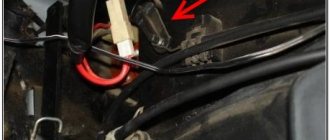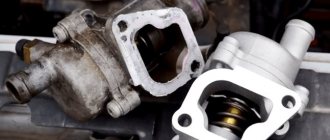Car owners will find out in the fall and winter that the injector or carburetor in the VAZ-2107 has stopped heating. Observant drivers are able to detect a malfunction of the stove in the summer - a breakdown of the heater is indicated by a leak of antifreeze or coolant. Without proper operation of the stove, it is impossible to increase the temperature inside the car; the air will blow cold.
A working stove raises the temperature well, so you shouldn’t endure and wait for the weather by the sea, especially if winter frosts are upon you - start repairing the heater yourself, and we’ll tell you how below.
Why does the stove in the VAZ-2107 heat poorly?
To eliminate a malfunction that occurred in the VAZ-2107 furnace equipment, it is necessary to establish the reason why the heater stopped functioning. A common reason is that the stove radiator, a pipe made of metal, or a faucet rusts. When rust appears, coolant leaks. Once the rust is removed, the stove will return to normal.
If rust has affected the radiator, most likely the part will have to be replaced with a new one; repairs can be made, but this requires extensive experience and knowledge in the repair business; only a service station specialist can handle it.
If there is cold air flow coming from the air duct, then it is time to check the condition of the heater valve, which is refusing to work due to the accumulation of dirt.
In this case, the repair is cleaning or replacing the radiator unit and heater tap.
Air lock preventing the stove from working properly
In our article we will look at another common problem, due to which the stove begins to forcefully blow cold air into the cabin. It consists in the formation of an air lock in the system. Diagnostics usually indicate the presence of the following causes for this malfunction:
- damage to the cylinder head gasket described above;
- poor-quality connection of pipes to each other. Usually, to eliminate this malfunction, it is enough to tighten the clamps well and check the integrity of the sealing elements;
- Improper coolant replacement, which allows air to enter the system.
Step-by-step instructions for replacing the radiator
What should I do to get the stove working again? First of all, replace or repair the radiator; to do this, follow these steps step by step:
- Drain the coolant into a container.
- Unscrew the 2 clamps located on the pipes of the old device from the engine compartment and remove the hoses.
- Unscrew the rubber seal retainer and then remove it completely.
- The interior of the VAZ-2107 will also have to work. Remove the panel where the radio is located, using a screwdriver or a 7mm wrench, unscrew the fastening element of the heater valve drive cable.
- Don't put the screwdriver down; you'll still need it to remove the spring-shaped brackets. There are four of them, the parts are located on the casing of the ventilation equipment.
- Slightly lower the cover downwards and then move it to the left.
- The radiator can now be pulled out.
- Proceed to inspect the old unit. Which product can not be changed? If there are no traces of leaks on the metal tubes, there is no corrosion. Corrosion is cleaned out, and leaking metal pipes are replaced. It happens that the heater tap lever is jammed, the point is that it no longer opens or there are problems with closing. When reinstalling radiator components, remember that good gaskets seal the fit of the parts to each other. Each gasket should be covered with silicone sealant; screw them securely, but without overtightening the fasteners.
- Rubber hoses that carry coolant along the entire path are also subject to lubrication with sealant.
- Assemble and mount the radiator exactly as indicated in the instructions, but in reverse order.
- If necessary, add antifreeze.
- All that remains is to turn on the ignition and check how tight the connection of the pipes with the hoses of the VAZ-2107 is.
What to do if the stove in the VAZ-2107 does not heat and the radiator is to blame is shown in the video: https://www.youtube.com/watch?v=gGOGR8EeHWI.
How to identify the problem and fix it
There are several reasons why the furnace blows cold air or does not work at all. In this case, you must proceed as follows:
- Check the faucet to see if it opens.
- Is the cold air damper capable of closing?
- With the car running, check the heater (heater radiator) for heating.
Radiator replacement
If the problem is in the radiator and it needs to be replaced, then proceed as follows:
- Drain the liquid.
- We unscrew the two clamps from the engine compartment, which are located on the radiator pipes. We remove the hoses.
- Unscrew and remove the fasteners on the rubber seal.
- We dismantle the radio panel and the cable fasteners on the heater valve drive. To do this job you will need a 7 key.
- Next, use a screwdriver to remove 4 spring clips from the fan casing. The casing drops down and slides to the left, after which the radiator can be pulled out.
- Now you can carefully examine the radiator, revive it or replace it with a new one. Assembly is carried out in the reverse order and does not involve any difficulties.
A broken radiator is a common cause of a non-functioning stove.
Restoring glass blowing
The stove that is installed on the VAZ-2107 has some design features, due to which the left pipe often does not blow the glass well enough. To put up with such an inconvenience in winter is difficult. Therefore, it is worth working to eliminate this problem. You must proceed according to the following scheme:
- We remove the deflector from the pipe by prying one of its sides with a screwdriver.
- The deflector body is held on the torpedo using small antennae. We put our hand inside and pull it out.
- The 50mm fan from the computer must be placed in the center of the dismantled case and marked in the appropriate places.
- In the plastic case, using a utility knife, hacksaw or sharp knife, cuts are made at the marks.
- The plastic easily breaks off along the line of cuts and an opening is obtained into which the fan is installed. It should fit snugly in place.
- We return the insides of the deflector to their place. The internal blades will not be able to rotate at full speed due to the changes made.
Other minor faults
Finding and fixing minor problems on your own is a handy skill for any car enthusiast.
After such actions it will be easy to determine the causes of the breakdown. And they can be as follows:
If the faucet is working properly, but the heater heats up only at high engine speeds and under such conditions begins to blow warm air, then the fault should be looked for in the pump or a coolant leak. To find a leak, you must carefully examine the required area of the cabin. If leaks are found, it is necessary to replace the hoses, tighten or install new clamps
Do not neglect the cap on the expansion tank. Tightness is the main condition under which the heater can function normally. Leaks can also occur due to rusting of the radiator, taps and other elements of the heating system
In this case, it is enough to simply replace the necessary part and enjoy a comfortable ride. The tightness can be checked in another simple way. Turn on the engine and wait 10 minutes. During this time, the expansion tank should warm up. If this does not happen, then we can talk about the lack of pressure that is necessary to supply antifreeze or antifreeze to the heater stove. If you notice that the car gets very hot when standing in a traffic jam, then you can talk about the lack of necessary pressure.
The stove can become clogged with various debris and become coated from the inside with oxides of various substances. In this case, it is necessary to clean out the debris and clean the system.
The car owner must be prepared for minor problems and be able to quickly fix them. For example, with the onset of winter, many VAZ-2107 owners’ stoves do not heat up and it is not always convenient to run to specialists with this problem.
What else can you do to make the VAZ-2107 stove warm?
Poor heating of the heater in the VAZ-2107 also occurs if the pipe located on the left, due to the intricacies of the car’s heater design, is not able to work properly, for example, to blow on the driver’s window. For this reason, the driver has no choice but to open the window in any weather. Another option for troubleshooting is to regularly wipe the glass with a cloth. Of course, all this causes a lot of inconvenience and, in the end, is simply annoying.
Therefore, it makes sense to modify the VAZ-2107 stove with your own hands. To do this, follow the instructions:
- Remove the deflector from the pipe by prying it from one side with a screwdriver, slightly pull it forward and do the same, but on the other side.
- The deflector body is mounted in the torpedo on medium-sized tendrils, so to get it out and remove it, you just need to stick your hand into the structure.
- After the deflector is removed, using a 50mm computer fan, measure in the middle of the case and be sure to mark the dimensions of the fan.
- Armed with a hacksaw or a sharp utility knife, make neat and precise cuts in the plastic.
- Combine the components together and break off the plastic pieces.
- You should try installing a fan in the resulting opening; make sure the connection is tight, otherwise it will start to wobble.
- Return the internal component of the deflector, which contains the blades, to its original place. If there is a part that is in the way, don’t be afraid to cut it off from the blades and holder, just don’t cut too much, especially since the blades are very fragile and can be easily damaged.
- Assemble the structure into one whole, check how correctly the blades move.
- Using cut sections of plastic, seal the unnecessary back cracks with the material; the plastic is fixed with sealant.
- Go to the interior of the VAZ-2107 - install a ventilation device in the pipe area, and then mount the deflector housing. Ideally, the fan should be directed into the hole made. Mount the blades.
- Cooper is connected to the heater wire.
- To make the cooler work, equip a key. If this is too troublesome for you, you can simply attach it to one wire going to the stove fan.
Common problems and solutions
Despite the simplicity of the design, the heating system of the VAZ-2107 fails quite often. Its most vulnerable places are:
- heater valve;
- fan (electric motor);
- stove radiator.
The heater valve of the “Seven”, like all classic VAZs, breaks down most often. Its most common malfunction is a leak caused by depressurization of the housing. This problem can be solved by replacing the spare part. Repairing the faucet is impossible in most cases.
Another common failure is a broken drive cable. To replace it, you will have to dismantle the tap, because it is impossible to get to its fastening on the side of the locking device without removing it. You should also monitor the cable tension. If you allow it to sag, the faucet valve will not open completely.
As for the fan, it cannot be called reliable. Usually it fails with the onset of cold weather. The cause of an electric motor malfunction, at best, is worn out bearings or brushes, at worst, a break or short circuit in the windings. Repairing the electric motor or replacing it can correct the situation.
The heater radiator also has two “diseases”: leaking and clogging. The first malfunction can be caused either by mechanical damage or by chemical processes. Today, radiators are made of aluminum alloy, which is not particularly resistant to technical fluids. And if old copper radiators could still be soldered, then modern ones can only be replaced.
Heat exchanger clogging also occurs as a result of chemical processes. Scale gradually settles on the walls of the device tubes and over time limits the normal circulation of the coolant. This leads to the fact that the air pumped into the cabin does not warm up to the required temperature. You can get rid of this problem by flushing the radiator with special liquids, or, in extreme cases, by replacing the device.
Heating and ventilation system
1 – air duct for heating the windshield; 2 – air supply cover; 3 – radiator; 4 – radiator casing; 5 – heater tap rod; 6 – outlet pipe; 7 – underwater pipe; 8 – heater tap; 9 – right air duct for heating the side window; 10 – side window heating nozzle; 11 – right air duct damper; 12 – additional resistor; 13 – air distribution cover; 14 – air duct damper for heating the windshield; 15 – fan electric motor; 16 – fan impeller; 17 – internal ventilation air duct; 18 – lever of the air distribution cover; 19 – outer lever of the windshield heating air duct damper;
20 – control lever bracket; 21 – control handle for the air duct dampers of the heated glass; 22 – air supply cover control handle; 23 – heater tap control handle; 24 – draft of the air supply cover; 25 – draft of the windshield heating flap; 26 – left air duct for heating the side window; 27 – central ventilation nozzles of the body interior; 28 – nozzle blade; 29 – nozzle; 30 – nozzle lever; 31 – gear wheel of the nozzle damper drive; 32 – rear seal of the air supply pipe; 33 – air supply pipe; 34 – front seal of the air supply pipe; 35 – air supply pipe valve; 36 – air supply pipe latch; 37 – damper with a gear sector.
Heater operation diagram
1 – air distribution cover; 2 – fan electric motor; 3 – impeller; 4 – heater tap; 5 – underwater pipe; 6 – outlet pipe; 7 – radiator casing; 8 – air supply hatch cover; 9 – hood;
10 – air duct for heating the windshield; 11 – air supply pipe; 12 – housing of the central ventilation nozzles of the body interior; 13 – control lever bracket; 14 – control handles; 15 – radiator; 16 – air duct damper for heating the windshield; 17 – internal ventilation air duct; 18 – air distribution cover lever
Common problems and solutions
Despite the simplicity of the design, the heating system of the VAZ-2107 fails quite often. Its most vulnerable places are:
- heater valve;
- fan (electric motor);
- stove radiator.
The heater valve of the “Seven”, like all classic VAZs, breaks down most often. Its most common malfunction is a leak caused by depressurization of the housing. This problem can be solved by replacing the spare part. Repairing the faucet is impossible in most cases.
Another common failure is a broken drive cable. To replace it, you will have to dismantle the tap, because it is impossible to get to its fastening on the side of the locking device without removing it. You should also monitor the cable tension. If you allow it to sag, the faucet valve will not open completely.
As for the fan, it cannot be called reliable. Usually it fails with the onset of cold weather. The cause of an electric motor malfunction, at best, is worn out bearings or brushes, at worst, a break or short circuit in the windings. Repairing the electric motor or replacing it can correct the situation.
The heater radiator also has two “diseases”: leaking and clogging. The first malfunction can be caused either by mechanical damage or by chemical processes. Today, radiators are made of aluminum alloy, which is not particularly resistant to technical fluids. And if old copper radiators could still be soldered, then modern ones can only be replaced.
Heat exchanger clogging also occurs as a result of chemical processes. Scale gradually settles on the walls of the device tubes and over time limits the normal circulation of the coolant. This leads to the fact that the air pumped into the cabin does not warm up to the required temperature. You can get rid of this problem by flushing the radiator with special liquids, or, in extreme cases, by replacing the device.
Heating and ventilation system
1 – air duct for heating the windshield; 2 – air supply cover; 3 – radiator; 4 – radiator casing; 5 – heater tap rod; 6 – outlet pipe; 7 – underwater pipe; 8 – heater tap; 9 – right air duct for heating the side window; 10 – side window heating nozzle; 11 – right air duct damper; 12 – additional resistor; 13 – air distribution cover; 14 – air duct damper for heating the windshield; 15 – fan electric motor; 16 – fan impeller; 17 – internal ventilation air duct; 18 – lever of the air distribution cover; 19 – outer lever of the windshield heating air duct damper;
20 – control lever bracket; 21 – control handle for the air duct dampers of the heated glass; 22 – air supply cover control handle; 23 – heater tap control handle; 24 – draft of the air supply cover; 25 – draft of the windshield heating flap; 26 – left air duct for heating the side window; 27 – central ventilation nozzles of the body interior; 28 – nozzle blade; 29 – nozzle; 30 – nozzle lever; 31 – gear wheel of the nozzle damper drive; 32 – rear seal of the air supply pipe; 33 – air supply pipe; 34 – front seal of the air supply pipe; 35 – air supply pipe valve; 36 – air supply pipe latch; 37 – damper with a gear sector.
Heater operation diagram
1 – air distribution cover; 2 – fan electric motor; 3 – impeller; 4 – heater tap; 5 – underwater pipe; 6 – outlet pipe; 7 – radiator casing; 8 – air supply hatch cover; 9 – hood;
10 – air duct for heating the windshield; 11 – air supply pipe; 12 – housing of the central ventilation nozzles of the body interior; 13 – control lever bracket; 14 – control handles; 15 – radiator; 16 – air duct damper for heating the windshield; 17 – internal ventilation air duct; 18 – air distribution cover lever
Let's sum it up
As you can see, even taking into account the simplicity of the design, repairing the VAZ 2107 stove can be a labor-intensive procedure due to difficult access to certain elements of the heating system.
Moreover, if such a need arises, modification and tuning of the VAZ stove, as well as maintenance and replacement of the VAZ 2107 heater with your own hands can be done independently in the conditions of an ordinary garage.
There is air in the engine cooling system: symptoms of airing, reasons for the formation of an air lock. How to bleed the engine cooling system.
Antifreeze boils and bubbles in the expansion tank. Causes of antifreeze or antifreeze boiling, main faults, troubleshooting, recommendations.
Reasons why coolant starts to leak. How to find the location of an antifreeze or antifreeze leak yourself. Useful tips and tricks.
Causes of air in the car engine cooling system and symptoms. How to remove an air lock from the cooling system, tips and tricks.
Why does the engine overheat or boil while the cooling radiator is cold? Signs of engine overheating, how to prevent serious consequences.
The VAZ 2110 heater does not work: the main reasons why the VAZ 2110 stove does not heat well. Diagnostics, replacement of VAZ 2110 heater radiator, modification.
Dismantling algorithm
VAZ cars of the classic family, which includes modification 2107, are good because to remove the heater radiator you do not need to dismantle the front panel, so the work of removing the heat exchanger of the interior heating system is not difficult. No specific tools are required, just 8 and 10 size screwdrivers and wrenches are needed.
Algorithm for removing the heater radiator:
Video: VAZ 2107 Replacing the heater radiator
- Drain the coolant by unscrewing the drain plugs on the engine and main radiator.
- On the left side of the engine shield (standing in front of the car) we look for two rubber tubes through which coolant is supplied and discharged to the heater. We loosen the clamps of these tubes and tighten them.
- We unscrew the screws securing the rubber seal through which the metal radiator pipes pass. Let's remove the seal.
- We move to the salon.
- We dismantle the shelf under the storage compartment on the passenger side. To do this, you need to unscrew the screws that secure it.
- Remove the lower part of the center console. It is attached to the floor and front panel with self-tapping screws. Since keys, a cigarette lighter, and a clock are installed on the lower part, after unscrewing the fastening elements, we move the box toward you (by turning on the reverse gear at the gearbox) and disconnect the wiring going to the indicated elements (it is better to mark the wires so as not to confuse them during assembly). After this, the box can be removed from the cabin.
- Unscrew the control mechanism cable from the antifreeze supply shut-off valve.
- We disconnect the lower part in which the fan is located from the stove body. It is attached to the top of the case using 4 latches installed on the sides. Use a screwdriver to pry up the latches, after which the lower part of the case will drop down. We move it to the side or completely remove it, having first disconnected the power wires of the fan motor.
- After dismantling the bottom of the case, you will have access to the radiator, which can be removed by pulling it down using the metal pipes.
Radiator installation
Note that this is only one of the methods for disassembling the stove on a VAZ-2107. It is not necessary to drain the antifreeze; you can disconnect the rubber tubes without removing them, and 1.0-1.5 liters of coolant will flow out of the cooling system, which are topped up after assembly. The main thing is that after disconnecting the tubes, lift their ends up and secure them in this position.
During the disassembly process, you can immediately disconnect the pipelines from the radiator along with the shut-off valve and then remove the heat exchanger itself.
How to identify the problem and fix it
There are several reasons why the furnace blows cold air or does not work at all. In this case, you must proceed as follows:
- Check the faucet to see if it opens.
- Is the cold air damper capable of closing?
- With the car running, check the heater (heater radiator) for heating.
Radiator replacement
If the problem is in the radiator and it needs to be replaced, then proceed as follows:
- Drain the liquid.
- We unscrew the two clamps from the engine compartment, which are located on the radiator pipes. We remove the hoses.
- Unscrew and remove the fasteners on the rubber seal.
- We dismantle the radio panel and the cable fasteners on the heater valve drive. To do this job you will need a 7 key.
- Next, use a screwdriver to remove 4 spring clips from the fan casing. The casing drops down and slides to the left, after which the radiator can be pulled out.
- Now you can carefully examine the radiator, revive it or replace it with a new one. Assembly is carried out in the reverse order and does not involve any difficulties.
Improvement of the heating system
The design of the VAZ 2107 stove is far from perfect. Therefore, car owners modify it in a variety of ways. First of all, attempts are being made to improve the tightness of air ducts, especially at joints. This allows you to slightly increase the efficiency of heating the interior.
VAZ 2107 owners modify the heating system in a variety of ways
Fan replacement
Often, to improve the operation of the stove, car enthusiasts replace their original fan with a more powerful one, used in other VAZ models (for example, VAZ 2108). The factory fan motor is mounted on plastic bushings, which wear out quickly. As a result, shaft play appears, and a whistling noise becomes audible in the cabin when the fan is operating. Repair and lubrication of bushings in this case, as a rule, do not bring the expected effect. The VAZ 2108 fan electric motor is mounted on bearings. Therefore, installing it in the VAZ 2107 stove will not only increase the efficiency of heating the interior, but will also make the operation of the fan more reliable.
Usually, along with the fan electric motor, a number of other elements of the stove control unit are also changed. The rotation speed of the VAZ 2107 factory fan at a current of 4.5A is 3000 rpm. The VAZ 2108 electric motor consumes 14A at a frequency of 4100 rpm. Therefore, when replacing, you should install the appropriate fuse, resistor (usually from a Niva) and speed switch (for example, from a Kalina).
Video: modification of the VAZ 2107 stove
To dismantle the fan you will need:
- flat and Phillips screwdrivers;
- keys for 7 and 10;
- round nose pliers.
The fan is removed in the following order.
- The instrument panel, shelf and glove box are dismantled.
- Use a 7 key to loosen the casing of the air damper control cable. The cable loop is removed from the lever.
- Use a 10mm wrench to unscrew the nut securing the heater housing.
- Use a flat screwdriver to remove the left and right air ducts from the heater body.
- Use a flat-head screwdriver to remove the latches that secure the fan to the stove.
- The wire terminals are disconnected.
- The fan is removed from the stove body.
- The impeller is removed. If necessary, use pliers.
The size of the new fan (from VAZ 2108) is slightly larger. Therefore, its installation will require some changes in the design of the stove. If only the motor is changed, it will be necessary to make an additional hole in the grille through which warm air enters the lower part of the cabin. If this is not done, the motor housing will rest against the grille.
Replacing the stove body
When installing a fan from a VAZ 2108, you will need to make a new frame, usually from plexiglass. This is quite labor-intensive and will require certain skills.
The material for a homemade frame when modifying the stove can be plexiglass
When making a new frame, all dimensions must be strictly observed. The slightest inaccuracies can lead to vibration or failure of the new fan. Having assembled the structure, you should lubricate the joints with sealant and install the new housing in place. After this, the noise level in the cabin usually decreases, and the stove begins to heat the air better.
When making a new frame for the motor, all dimensions must be strictly observed.
Other stove tuning options
Sometimes the design of the air ducts is modified. Additional holes are made in the stove body into which plumbing hoses are inserted. Through these hoses, connected to the side and bottom air ducts, when the engine is running, an additional flow of warm air is created onto the windows and into the legs.
Often the cause of poor interior heating is a clogged heater radiator. The coolant begins to circulate more slowly or completely stops circulating through the heating system, and the efficiency of air heating decreases noticeably. Usually in these cases the radiator is replaced with a new one.
A clogged heater radiator leads to a decrease in the efficiency of heating the interior.
Control mechanism
The control of the VAZ 2107 stove is mechanical. It consists of a fan switch and a block of sliders. The control mechanism is installed on the center console at the top, which provides easy access to the elements.
There are three sliders of the control mechanism, and each of them controls its own element:
- The top one is responsible for supplying antifreeze to the radiator and is connected by a cable to a tap installed on the inlet pipe. The extreme left position of the slider means the tap is closed (the stove does not heat), the right position means the tap is open (antifreeze enters the radiator).
- Middle – air supply damper control. When you move it to the left, the damper shuts off the air supply from the street (closed air circulation in the cabin), while the right position means the air flow is open (air from the street enters the cabin).
- The lower one controls the damper for distributing the flow through the air ducts. Left position - the flow is supplied through the side and central deflectors, right - to the windshield area. Each of these sliders can be adjusted to any position to achieve optimal stove operation.
Reasons for decreased performance
In addition to obvious malfunctions due to which the stove does not work or functions incorrectly, there are other problems with the heating system of the VAZ-2107 interior. The main one is a decrease in stove performance.
If the stove heats poorly, then the reason lies in:
- Malfunctions of the power plant cooling system (reduced pump performance, stuck thermostat).
- Radiator clogged.
- Formation of an air lock in the heater radiator.
- The air intake damper seal is worn out.
To find the cause of decreased performance, start by checking the heating of the heater radiator. To do this, heat the engine to operating temperature, fully open the antifreeze supply valve to the stove and hand check the degree of heating of the supply pipe before and after the valve and the radiator itself. If the pipeline is hot before the tap, but not after it, the tap is jammed. If the radiator does not warm up, the reason lies in severe clogging of the heat exchanger or a plug in it. If the pipeline does not warm up even to the tap, inspect the cooling system.
If the radiator warms up well, but it is noted that the stove heats worse, then check the functionality of the air intake damper and the condition of its seal. It wouldn’t hurt to check the stove body and air ducts for leaks and cracks.
To ensure that the VAZ-2107 heater heats well, before the winter period check the functionality of the tap, replace the antifreeze (with flushing the system), inspect the control mechanism and the functionality of the dampers.
Car owners will find out in the fall and winter that the injector or carburetor in the VAZ-2107 has stopped heating. Observant drivers are able to detect a malfunction of the stove in the summer - a breakdown of the heater is indicated by a leak of antifreeze or coolant. Without proper operation of the stove, it is impossible to increase the temperature inside the car; the air will blow cold.
A working stove raises the temperature well, so you shouldn’t endure and wait for the weather by the sea, especially if winter frosts are upon you - start repairing the heater yourself, and we’ll tell you how below.

